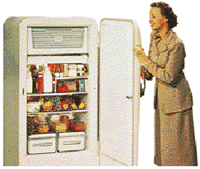 |
Switching from driving an average
car to a 13mpg SUV for one year would waste more energy
than if you... |
- Left your refrigerator door open for
6 years
- Left your bathroom light burning for
30 years or
- Left your color television turned on
for 28 years
In this report:
Background
The SUV Threat
Pollution
Energy Security
Safety
Take Action
Background
When it comes to wasting energy, SUVs are
unrivaled. Built with outdated, gas-guzzling technology, many
SUVs get just 13 miles per gallon. And the higher gas prices
are, the more money they waste.
Auto-industry advertising portrays SUVs as
the ticket to freedom and the great outdoors. Commercials depict
them climbing massive snow-capped mountains or tearing through
desert sand dunes, taking their owners into the wild. In
reality, the only off-road action many of these vehicles see is
accidentally driving through a flower bed next to the driveway.
Missing from these ads are other
contributions from SUVs—the brown haze of air pollution hanging
over many of our national parks, images of weather disasters
linked to global warming or the oil derricks and tankers needed
to feed gas-guzzling SUVs. In contrast to Detroit's carefully
crafted image, SUVs have a dark side. They spew out 43 percent
more global-warming pollution and 47 percent more air pollution
than an average car. SUVs are four times more likely than cars
to roll over in an accident and three times more likely to kill
the occupants in a rollover. They also cost the owner thousands
more on gasoline.
|
Worsening the Threat
of Global Warming
Because the government
classifies SUVs as "light trucks" rather than
cars, SUVs have a license to guzzle more gas and
pollute more than cars. In 1975, when
fuel-economy standards were first adopted,
"light truck" referred to a vehicle used to haul
hay on the farm or gravel at a construction
site. At that time, light trucks comprised only
20 percent of the vehicle market. Today, SUVs,
mini-vans and other light trucks make up nearly
half of new vehicles sold. They are far more
likely to haul lattés home from Starbucks than
lumber from the yard. Even though Detroit has
technology that could make them both cleaner and
safer, SUVs and other light trucks are still
held to low environmental standards, roll over
more than cars and pose greater danger to other
vehicles than cars do.
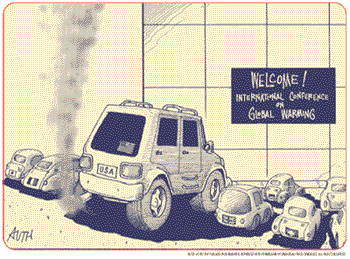 |
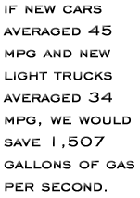 The
world's leading climate scientists have warned
that there is now 30 percent more carbon
dioxide—the primary global-warming gas—in the
atmosphere than a century ago. The burning of
fossil fuels is the primary source of this CO2
pollution. Over the same period of time, the
average surface temperature of the earth has
risen more than 1 degree Fahrenheit. The
world's leading climate scientists have warned
that there is now 30 percent more carbon
dioxide—the primary global-warming gas—in the
atmosphere than a century ago. The burning of
fossil fuels is the primary source of this CO2
pollution. Over the same period of time, the
average surface temperature of the earth has
risen more than 1 degree Fahrenheit.
Due to these changes, we
are already seeing signs of global warming. The
1990s was the hottest decade on record and the
11 hottest years on record have all occurred in
the past 13 years.
Extreme drought conditions
and changing rainfall patterns have occurred
across the country, setting the stage for
wildfires, which decimated areas from Florida to
California. Record heat waves have killed
hundreds in Chicago and infectious-disease
outbreaks linked to global warming have sickened
or killed hundreds from Texas to New York, shut
down Disney World and re-introduced Americans to
dengue fever, malaria and encephalitis. Sea
levels have risen between four and 10 inches and
glacial ice is rapidly retreating on five
continents.
The world's leading
scientists warn that over the 21st century, CO2
levels are expected to double, raising sea
levels two feet or more, worsening smog and
leaving our children to cope with a more hostile
climate.
America's cars and light
trucks alone produce nearly 20 percent of U.S.
CO2 pollution. That's more than all but four
countries worldwide! And transportation is the
fastest-growing sector of global-warming
pollution in the nation. Popular light trucks
pump out 237 million tons of global-warming
pollution into our atmosphere each year. That's
because every gallon of gas burned emits 28
pounds of CO2 into the atmosphere.
SUVs Emit More Air
Pollution Than Cars
Nearly 117 million
Americans live in areas where the air is
unhealthy to breathe, according to the American
Lung Association. Light trucks, which can spew
up to three times more smog-forming pollution
than cars, magnify this growing health threat.
The increased air pollution can lead to more
asthma, bronchitis and other health problems.
U.S. autos emit more
CO2 than all but four countries.
Top 5 Global-Warming
Polluters:
- U.S.
- China
- Russia
- Japan
- U.S. autos
Air pollution is not
exclusively an urban problem. National parks
from Maine's Acadia to Virginia's Shenandoah and
North Carolina's Great Smokey Mountains all have
severe air-pollution problems that match major
metropolitan areas. Pollution monitors are now
installed at some trailheads in Mt. Rainier
National Park to warn hikers when smog reaches
unsafe levels.
The U.S. Environmental
Protection Agency adopted new "Tier 2" tailpipe
pollution standards in 1999 to cut smog (but not
CO2) from cars and SUVs. However, these rules
will not go into effect until 2004 and the auto
industry has until 2009 to clean up its largest
SUVs.
The More You
Guzzle, The More You Pollute
Represented below is the total tonnage of CO2
produced by SUVs and other vehicles over a
124,000-mile lifetime.
Ford Excursion (13 mpg)
Jeep Grand Cherokee (18 mpg)
Ford Taurus (23 mpg)
Honda Civic HX (36 mpg)
Honda
Insight (65 mpg) |
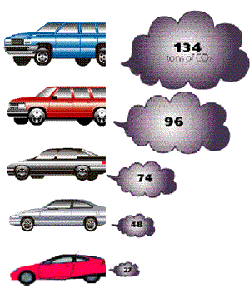 |
|
|
|
SUVs Increase Our Oil Addiction,
Threaten Our Wilderness and Coasts
 A
hidden cost of SUVs is the price we pay with our natural
resources. To keep these gas guzzlers running, oil
companies seek to drill in new areas—including some of
our nation's most sensitive wilderness habitats. As the
number of gas guzzlers on the road grows, so does the
pressure to drill in Alaska's Arctic National Wildlife
Refuge—one of the last remaining pristine ecosystems.
Fragile coastlines in California and Florida, and lands
surrounding Yellowstone National Park are also targets
for drilling. A
hidden cost of SUVs is the price we pay with our natural
resources. To keep these gas guzzlers running, oil
companies seek to drill in new areas—including some of
our nation's most sensitive wilderness habitats. As the
number of gas guzzlers on the road grows, so does the
pressure to drill in Alaska's Arctic National Wildlife
Refuge—one of the last remaining pristine ecosystems.
Fragile coastlines in California and Florida, and lands
surrounding Yellowstone National Park are also targets
for drilling.
The Exxon Valdez disaster serves
as a powerful reminder that transporting oil also
threatens our environment. Smaller spills and leaks
occur daily, putting waterways and wildlife at risk.
Worsening our
Energy Security
Every day America consumes 18
million barrels of oil. We import nearly half of this
oil (the same amount guzzled by cars and light trucks)
from politically volatile regions. Our oil imports add
$50 billion to the U.S. trade deficit annually. Due to
the increasing number of gas-guzzling vehicles, America
is more dependent on foreign oil now than we were at the
height of the 1973 energy crisis.
Congress passed the Corporate
Average Fuel Economy (CAFE) standards in 1975 to reduce
our dangerous oil dependence. This doubled the fuel
economy of America's vehicle fleet, saving 3 million
barrels of oil per day. However, the oil savings from
CAFE standards are being eroded by people driving
farther and the rising proportion of inefficient SUVs
and other light trucks. In fact, the average fuel
economy of new vehicles has sunk to the lowest level
since 1980. Raising the CAFE standard for light trucks
to equal that of cars (27.5 mpg) would save 1 million
barrels of oil per day. We can do even better. Raising
the average for cars to 45 mpg and light trucks to 34
mpg would save 3 million barrels of oil per day.
|
Lowest Fleet
Fuel Economy Average Since 1980
The fuel economy average for both cars and
trucks is at its lowest pint since 1980. (US EPA
Light-Duty Automotive Tecnology and Fuel Economy
Trends Through 1999, Spet. 1999) |
|
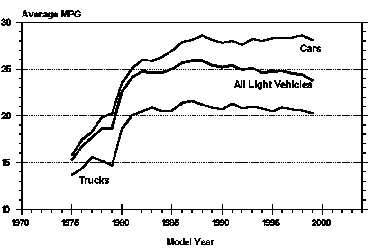 |
Available technology and higher
mileage standards could make the popular Ford Explorer a
34.1 mpg vehicle, rather than a 19.3 mpg guzzler,
without compromising performance or safety. This
"improved" Explorer could emit 43 percent less
global-warming pollution and 76 percent less
smog-forming pollution and cost only $935 more.
Consumers would save several times this at the gas pump
over the life of the vehicle.
Industry
Foot-Dragging and Excuses
History shows that automakers
won't improve the environmental performance of their
products unless they are required to put technology to
work. Raising CAFE standards is the key to cleaning up
SUVs and other light trucks.
In 1974, a Ford official testified
before Congress that CAFE standards would "result in a
Ford product line consisting of either all
sub-Pinto-sized vehicles or some mix of vehicles ranging
from a sub-sub-compact to perhaps a Maverick." Today,
automakers use similar arguments against improving CAFE
standards for SUVs. The claim wasn't true then; it isn't
true today. Eighty-six percent of the fuel-economy
improvements for cars have resulted from improved
technologies such as more efficient engines and
transmissions and better aerodynamics.
In July 2000, Ford promised to use
technology that will improve its SUVs' fuel economy by
25 percent over five years. General Motors pledged to
exceed Ford's light-truck fuel economy. Keeping these
promises will begin the process of cleaning up SUVs.
But Detroit continues to fight
higher CAFE standards for light trucks and cars, which
would guarantee these and other improvements. The auto
industry has taken its fight to Congress, getting its
friends to fight legislation that would increase fuel
economy. Beginning in 1995, Congress froze CAFE
standards at levels set decades ago. |
|
Americans
Deserve Vehicles That Are Both Safe and Clean
Detroit opposes CAFE standards,
claiming that they cannot make a safe, clean SUV.
Contrary to the auto industry's arguments, CAFE
standards don't dictate automobile size or safety.
Design, not weight, is the key to both safety and fuel
economy. Engineering and safety features like airbags
and crush-resistant roofs can ensure that vehicles
absorb crash forces so occupants don't. Crash-test
results show that automakers are making safe and unsafe
cars of all sizes. In a standard head-on crash test into
a wall, occupants of a 1997 Ford Expedition faced
greater risk of injury or death than occupants of a 1997
Saturn subcompact. This is because the Saturn has
crashworthiness designed into it and the Expedition does
not.

"Ford
Motor Company, which depends on sport utility vehicles
for much of its profit... said that the vehicles
contribute more than cars to global warming, emitted
more smog-causing pollution and endangered other
motorists."
New
York Times, May 12, 2000
The same industry claimed the
original CAFE law was a threat to highway safety,
battled automotive safety improvements from seatbelts to
airbags and continues to fight a rollover standard. The
fact is that since 1975 CAFE standards doubled fuel
economy and the rate of highway fatalities fell by 50
percent.
The SUV Safety
Story: Rollovers and Dangers to Others on the Road
Here's what the New York Times
said about SUV safety (July 15, 1999): "Because it is
taller, heavier and more rigid, an SUV or a pickup is
more than twice as likely as a car to kill the driver of
the other vehicle in a collision. Yet partly because
these so-called light trucks roll over so often, their
occupants have roughly the same chance as car occupants
of dying in a crash."
SUVs give a false impression of
safety. With their height and comparatively narrow
tire-track width, SUVs handle and maneuver much less
effectively than cars. Emergency swerves to avoid a
crash can themselves lead to rollover accidents in SUVs,
which are four times more likely to roll over in an
accident. Rollovers account for 62 percent of SUV deaths
but only 22 percent in cars. Yet automakers continue to
fight new standards that would protect occupants in
rollover accidents.
Because SUVs are built on high,
stiff frames, their bumpers ride above the
occupant-protecting frame of cars. When an SUV and a car
collide, this height difference, combined with the stiff
battering-ram frame and greater mass, create a lethal
weapon.
According to a government study,
in 1996 "at least 2,000 car occupants would not have
been killed, had their cars collided with other cars
instead of trucks of the same weight." And SUVs are also
more deadly to pedestrians, bicyclists and motorcyclists
than cars, in part because existing braking standards
for SUVs are weaker than for cars. |
|



 The
world's leading climate scientists have warned
that there is now 30 percent more carbon
dioxide—the primary global-warming gas—in the
atmosphere than a century ago. The burning of
fossil fuels is the primary source of this CO2
pollution. Over the same period of time, the
average surface temperature of the earth has
risen more than 1 degree Fahrenheit.
The
world's leading climate scientists have warned
that there is now 30 percent more carbon
dioxide—the primary global-warming gas—in the
atmosphere than a century ago. The burning of
fossil fuels is the primary source of this CO2
pollution. Over the same period of time, the
average surface temperature of the earth has
risen more than 1 degree Fahrenheit. 
 A
hidden cost of SUVs is the price we pay with our natural
resources. To keep these gas guzzlers running, oil
companies seek to drill in new areas—including some of
our nation's most sensitive wilderness habitats. As the
number of gas guzzlers on the road grows, so does the
pressure to drill in Alaska's Arctic National Wildlife
Refuge—one of the last remaining pristine ecosystems.
Fragile coastlines in California and Florida, and lands
surrounding Yellowstone National Park are also targets
for drilling.
A
hidden cost of SUVs is the price we pay with our natural
resources. To keep these gas guzzlers running, oil
companies seek to drill in new areas—including some of
our nation's most sensitive wilderness habitats. As the
number of gas guzzlers on the road grows, so does the
pressure to drill in Alaska's Arctic National Wildlife
Refuge—one of the last remaining pristine ecosystems.
Fragile coastlines in California and Florida, and lands
surrounding Yellowstone National Park are also targets
for drilling.
